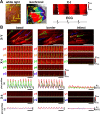Spatiotemporally Non-Uniform Ca2+ Dynamics of Cardiac Purkinje Fibers in Mouse Myocardial Infarct
- PMID: 28903013
- PMCID: PMC5665107
- DOI: 10.1369/0022155417730280
Spatiotemporally Non-Uniform Ca2+ Dynamics of Cardiac Purkinje Fibers in Mouse Myocardial Infarct
Abstract
Surviving Purkinje fibers in myocardial infarct are regarded as an important substrate in arrhythmogenesis. However, poorly understood are functional properties of Purkinje fibers in the infarcted heart. We sought to visualize intracellular Ca2+ ([Ca2+]i) dynamics of Purkinje fiber networks in the mouse myocardial infarct. Using 3- to 4-day-old or 7- to 9-day-old infarcted hearts after the left coronary-artery ligation corresponding, respectively, to acute or healing phase, we conducted rapid fluo4-fluorescence imaging on the endocardial surface of the left ventricular septum by macro-zoom fluorescence microscopy and rapid-scanning confocal microscopy. In contrast with the intact heart, where uniform Ca2+ transients propagated rapidly, the infarcted heart exhibited slow, non-uniform impulse propagations. On confocal microscopy, Purkinje fibers in the peri-infarct zone exhibited non-uniform [Ca2+]i dynamics: beat-to-beat alternans of the Ca2+ transient amplitude in and among the individual fibers, whereas the intact fibers exhibited uniform Ca2+ transients. Such non-uniform [Ca2+]i dynamics were more conspicuous in the acute infarcted hearts than in the healing ones. In accordance with [Ca2+]i dynamics, fixed fluo4-loaded heart preparations exhibited definitive connexin-40 plaques in the peri-infarct Purkinje fibers, whereas the subjacent myocardium presented coagulative necrosis and granulation tissues, respectively. The surviving Purkinje fibers in the peri-infarct zone exhibited non-uniform [Ca2+]i dynamics, which may lead to arrhythmogenesis.
Keywords: alternans; arrhythmia; calcium; heart; histopathology.
Conflict of interest statement
Figures






References
-
- Tawara S. The conduction system of the mammalian heart: an anatomico-histological study of the atrioventricular bundle and the Purkinje fibers. London: Imperial College Press; 2000.
-
- Miquerol L, Meysen S, Mangoni M, Bois P, van Rijen HV, Abran P, Jongsma H, Nargeot J, Gros D. Architectural and functional asymmetry of the His-Purkinje system of the murine heart. Cardiovasc Res. 2004;63:77–86. - PubMed
-
- Tanaka H, Hamamoto T, Takamatsu T. Toward an integrated understanding of the Purkinje fibers in the heart: the functional and morphological interconnection between the Purkinje fibers and ventricular muscle. Acta Histochem Cytochem. 2005;38:257–65.
-
- Daniel TM, Boineau JP, Sabiston DC., Jr. Comparison of human ventricular activation with a canine model in chronic myocardial infarction. Circulation. 1971;44:74–89. - PubMed
-
- Friedman PL, Stewart JR, Wit AL. Spontaneous and induced cardiac arrhythmias in subendocardial Purkinje fibers surviving extensive myocardial infarction in dogs. Circ Res. 1973;33:612–26. - PubMed
Publication types
MeSH terms
Substances
LinkOut - more resources
Full Text Sources
Other Literature Sources
Medical
Miscellaneous

